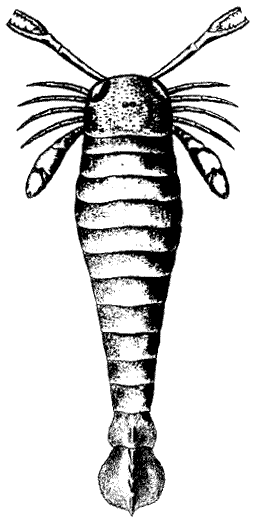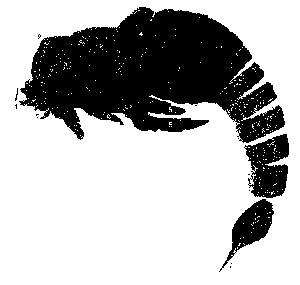Suborder Pterygotina

Pterygotus (Acutiramus) buffaloenisis Pohlman
late Silurian (Ludlow)
New York
length about 2 meters
illustration from Fenton and Fenton The Fossil Book

Introduction
Slimoniidae
Pterygotidae
Jaekelopteridae
Links
The Pterygotina
The Pterygotids are among the most spectacular of the eurypterids, in the more advanced forms
equipped with large chelicerae or "pincers". In most eurypterids, the chelicerae
are rather small; only in the Pterygotina do they grow into large pincer-type
grasping organs as those shown here. But despite their resemblance,
these chelicerae are not homologous
to the pincers of scorpions
(i.e. they are not formed from the same pair of limbs). Scorpion
pincers are the second pair of appendages, whereas pterygotid pincers are
the first. These animals were active hunting by site predators, as
indicated by the large bulbous eyes, located at the side (rather than the
middle) of the head, giving superior peripheral vision.
As with most Eurypterid lineages, the Pterygotina reached their acme
in the late Silurian and early Devonian, at the time the great deltas of
Euramerica and elsewhere were creating a rich near-shore detritus-based
food-chain that enabled the armoured ostracoderms and many other prey-animals
to flourish.

Slimonia
acuminata Salter 1856
length about a meter
Early to Middle Silurian (Llandovery to early Wenlock), Scotland (central Euramerica)
illustration from SENCKENBERG
Exponat April 1996
family Slimoniidae

time range: Llandovery to Pridoli
known distribution: Euramerica
habitat: Marginal Marine? Brackish and Fresh water
size: 60 cm to a meter or more in length
description: Large forms with smooth outer surface, quadratic prosoma with small compound eyes at the side of the head; postabdomen narrow, front half of Pterygotus-like telson strongly expanded and flattened; walking legs with denticles but lacking spines; The metastoma is narrowly cordate (heart-shaped) in outline; the
genital appendage is
long and narrow in both sexes.
notes: Previously included under the family Hughmilleriidae, these primitive Pterygotines lack the distinguishing cheliceratic pincers but in other respects were
similar to the typical Pterygotines. The eyes, although smaller than those of Pterygotus, are large
in comparison to other Eurypterids, indicating an active predator that hunted by sight. Unlike the more advanced representatives of the group, the Slimoniids inhabited brackish and fresh water

Pterygotus (Pterygotus) rhenaniae Jaekel
early Devonian
Germany
length
up to 1.8 meters
illustration from Moore, Lalicker and Fischer, Invertebrate Fossils
family Pterygotidae
 Family Pterygotidae Clarke & Ruedemann, 1912
Family Pterygotidae Clarke & Ruedemann, 1912
time range: - Floian to Famennian
known distribution: Euramerica
habitat: Marginal Marine? Brackish and Fresh water
size: Although some species were small, many grew to great size. The largest known complete specimen is "only" one and a quarter meters in length, but isolated segments and body parts indicate these animals typically reached 1.5 to 1.8 meters, with large forms exceeding 2 meters in length.
Rivaled only by the enormous (but harmless) millipede-like arthropleurids of the Carboniferous, this was the largest size ever attained by an
arthropod.
representative taxa: Pterygotus (Acutiramus) buffaloenisis Pohlman, Pterygotus (Pterygotus) rhenaniae Jaekel, Pterygotus (Pterygotus) anglicus Agassiz,
description: Small to very large forms - distinguished by very large and long chelicerae in the form of "pincers" provided with strong teeth. The exoskeleton ornamented with distinct
semilunate scales; and the broad flattened telson, which may have served a stabilizing
function when the animal swam. The epistoma
is present; the walking legs are generally small, slender, and lacking spines. The metastoma is suboval to heart-shaped in outline; the
genital appendage is short and pear shaped in the type "B" form, and somewhat short, narrow and blunt in the type "A" form.
Pterygotids were also unusual among eurypterids in that, although preferring marginal marine (deltaic) environments, also inhabited typically marine environments, where they clearly served the role of top
predator in the benthic food-chain. These animals were clearly to large, and their walking legs too small, to have ventured onto land. They did not even move into fresh-water ecosystems.
family Jaekelopteridae
time range: Pragian to Emsian
habitat: Marine
representative taxa: Jaekelopterus
description: resemble the Pterygotids in the possession of large "pincer"-like chelicerae.
Links: Systematics of the Eurypterida
graphics from Treatise on Invertebrate Paleontology
vol. P. - Chelicerata - Merostomata; and Fenton and Fenton The Fossil Book (1958, Doubleday & Co., Garden City, New York); and Moore, Lalicker and Fischer, Invertebrate Fossils, 1952, McGraw-Hill Book Company, Inc., New
York, Toronto, London)
images not loading? | error messages? | broken links? | suggestions? | criticism?



![]()



 Family Pterygotidae Clarke & Ruedemann, 1912
Family Pterygotidae Clarke & Ruedemann, 1912